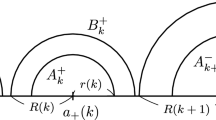Abstract
Let N be a nilpotent Lie group and K a compact subgroup of the automorphism group Aut(N) of N. It is well known that if \((K\ltimes N,K)\) is a Gelfand pair then N is at most 2-step nilpotent Lie group. This notion has been generalized to non-compact groups K. In this work, we exhibit a family \((K_m\ltimes N_m,K_m)\) of generalized Gelfand pairs, where \(N_m\) is a \(m+2\)-step nilpotent Lie group and \(K_m\) is isomorphic to \({\mathbb {R}}^{m+1}\).
Similar content being viewed by others
References
Astengo, F., Di Blasio, B., Ricci, F.: Gelfand transforms of polyradial functions on the Heisenberg group. J. Funct. Anal. 251, 772–791 (2007)
Benson, C., Jenkins, J., Ratcliff, G.: On Gelfand pairs associated with solvable Lie groups. Trans. Am. Math. Soc. 321, 85–116 (1990)
Benson, C., Jenkins, J., Ratcliff, G.: Bounded K-spherical function on Heisenberg group. J. Funct. Anal. 105, 409–443 (1992)
Benson, C., Jenkins, J., Ratcliff, G.: The orbit method and Gelfand pairs associated with nilpotent Lie groups. J. Geom. Anal. 9, 569–582 (1999)
Dixmier, J.: Sur les representations unitaires des groupes de Lie nilpotents. III. Can. J. Math. 10, 321–348 (1958)
Faraut, J.: Distributions sphériques sur les espaces hyperboliques. J. Math. Pures Appl. 58, 369–444 (1979)
Fischer, V., Ricci, F., Yakimova, O.: Nilpotent Gelfand pairs and spherical transforms of Schwartz functions III. Isomorphisms between Schwartz spaces under Vinberg condition. arxiv:1210.7962
Gallo, A., Saal, L.: A generalized Gelfand pair attached to a \(3\)-step nilpotent Lie group. J. Fourier Anal. Appl. 26, 62 (2020)
Kirillov, A.A.: Unitary representations of nilpotent Lie groups. Russ. Math. Surv. 17, 53–104 (1962)
Kobayashi, T.: Multiplicity free representations and visible actions on complex manifolds. Publ. RIMS Kyoto Univ. 41, 497–549 (2005)
Lauret, J.: Gelfand pairs attached to representations of compact Lie groups. Transform. Groups 5, 307–324 (2000)
Mackey, G.W.: Unitary Group Representations in Physics, Probability, and Number Theory. Mathematics Lecture Note series, Benjamin/Cummings Publishing, San Francisco (1978)
Mokni, K., Thomas, E.G.F.: Paires de Guelfand généralisées associées au groupe d’Heisenberg. J. Lie Theory 8, 325–334 (1998)
Ratcliff, G.: Symbols and orbits for \(3\)-step nilpotent Lie groups. J. Funct. Anal. 62, 38–64 (1985)
Thomas, E.G.F.: The Theorem of Bochner Schwartz Godement for Generalized Gelfand Pairs. Elsevier, Amsterdam (1984)
Van Dijk, G.: Group representations on spaces of distributions. Russ. J. Math. Phys. 2, 57–68 (1994)
Vinberg, E.B.: Commutative homogeneous spaces and co-isotropic symplectic actions. Russ. Math. 56, 1–60 (2001)
Acknowledgements
We are indebted to Jacques Faraut for his generous contribution to this work. Also we thank Rocío Díaz Martin for helpful conversations. We wish to thank the referee for suggesting improvements to an earlier version of this paper.
Author information
Authors and Affiliations
Corresponding author
Additional information
Publisher's Note
Springer Nature remains neutral with regard to jurisdictional claims in published maps and institutional affiliations.
Appendix
Appendix
In the following, we denote by \(E_{i,j}\) the matrix of \(M_{m+3}({\mathbb {R}})\) that has 1 in the (i, j) position and 0 elsewhere.
Lemma 1
The map \(\Phi :N_m\rightarrow M_m\) defined by
is an isomorphism of Lie groups.
Proof
The proof is by induction on m. For \((s'_m,s'_{m-1},\ldots ,s'_1,x',y',t')\in N_m\) we set
We assume that \(\Phi _{m-1}:N_{m-1}\rightarrow M_{m-1}\) is an isomorphism of groups. Since \(s_m\) defines an automorphism on \(M_{m-1}\) and \(s_m\circ \Phi _{m-1}=\Phi _{m-1}\circ s_m\), we have that
where we have used the action of \(s_m\) on \(M_{m-1}\). So, as \(\Phi (s_m,0,\ldots ,0)=I+(-1)^ms_m E_{1,m+3}\), we have that
Also, it is easy to see that
So, by definition of semidirect product, (11), (12), (13), and (10), we have that
\(\square \)
Rights and permissions
Springer Nature or its licensor (e.g. a society or other partner) holds exclusive rights to this article under a publishing agreement with the author(s) or other rightsholder(s); author self-archiving of the accepted manuscript version of this article is solely governed by the terms of such publishing agreement and applicable law.
About this article
Cite this article
Campos, S., García, J. & Saal, L. Generalized Gelfand Pairs Associated to m-Step Nilpotent Lie Groups. J Geom Anal 33, 54 (2023). https://doi.org/10.1007/s12220-022-01099-4
Received:
Accepted:
Published:
DOI: https://doi.org/10.1007/s12220-022-01099-4



